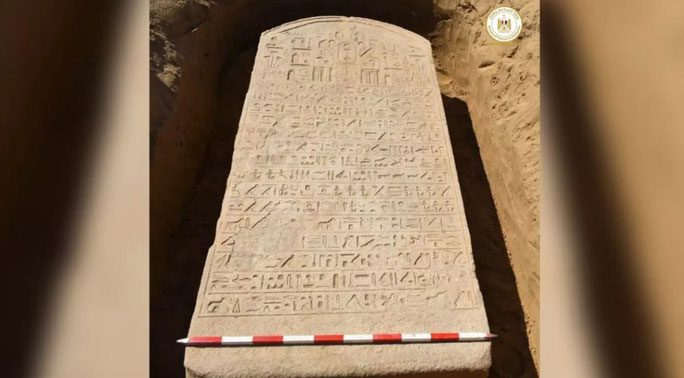The treasure that a fortunate Egyptian farmer discovered is a stone slab inscribed with hieroglyphs belonging to Pharaoh Apries, who ruled Egypt from 589 to 570 BC.
According to the unnamed farmer, he was plowing the land in preparation for the new harvest when he stumbled upon the unusual stone slab, covered with hieroglyphs. He promptly reported his find to the police of the Egyptian Ministry of Tourism and Antiquities.

Close-up of the Egyptian treasure accidentally found by the farmer – (Photo: Egyptian Ministry of Tourism and Antiquities).
Live Science reported that the subsequent excavation revealed a complete rectangular stone slab measuring 230 cm long, 103 cm wide, and 45 cm thick. This massive slab is engraved with a multi-winged sun disk – a symbol of the Sun God Ra, while 15 lines of hieroglyphs below declare the reign of Pharaoh Apries, also known as Wahibre Haaibre, who ruled during Egypt’s 26th dynasty in the period of Egypt’s independence, with its capital located in Sais, northern Egypt.
The remaining contents of the slab remain a mystery. Mr. Mostafa Waziri, Secretary-General of the Supreme Council of Antiquities, stated that archaeologists are working diligently on the translation but have already grasped the general meaning of the inscriptions, which describe a military campaign undertaken by this pharaoh in eastern Egypt.
These stone slabs bearing hieroglyphs provide invaluable information about the fascinating world of ancient Egyptians. Given its age, excellent preservation, and the information inscribed on it, it can be said that the farmer has truly found a treasure.
According to the ancient Greek historian Herodotus (who lived from 484 to 425 BC), Pharaoh Apries fought and was defeated by the Phoenicians, resulting in many Egyptian soldiers’ deaths, which led to prolonged civil strife and ultimately the death of the pharaoh himself.



















































